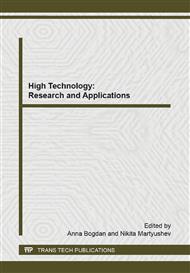[1]
T. -L. Chiang, Y. -C. Wang, W. -H. Ding, Trace determination of rhodamine B and rhodamine 6G dyes in aqueous samples by solid-phase extraction and high-performance liquid chromatography coupled with fluorescence detection, J. Chin. Chem. Soc., 59 (2012).
DOI: 10.1002/jccs.201100318
Google Scholar
[2]
C. Desiderio, C. Marra, S. Fanali, Quantitative analysis of synthetic dyes in lipstick by micellar electrokinetic capillary chromatography, Electrophoresis, 8-9 (1998) 1478-1483.
DOI: 10.1002/elps.1150190844
Google Scholar
[3]
J. Yan, Y. Xu, H. Zhu, Test and the monitor techniques of waterflood front and fracture, Fault-block Oil & Gas Field, 12, (2005) 59-62.
Google Scholar
[4]
M.A. Gavrilenko, N.A. Gavrilenko, S.K. Amerkhanova, A.S. Uali, A.A. Bilyalov, Trace Determination of Rhodamine and Eosine in Oil-Water Reservoir Using Solid-Phase Extraction, Advanced Materials Research, 880 (2014) 276-281.
DOI: 10.4028/www.scientific.net/amr.880.276
Google Scholar
[5]
M.A. Gavrilenko, N.A. Gavrilenko, Polymethacrylate sorbent for solid phase extraction of amines, Mendeleev Communication, 2 (2006) 117-119.
DOI: 10.1070/mc2006v016n02abeh002125
Google Scholar
[6]
M.A. Gavrilenko, N.A. Gavrilenko, G.M. Mokrousov, Preconcentration of phenols on a polymethacrylate sorbent for their gas-chromatographic determination in water, J. Analytical Chemistry. 61 (2006) 216-218.
DOI: 10.1134/s1061934806030038
Google Scholar
[7]
J. -H. Huang, K. -L. Huang, S. -Q. Liu, A.T. Wang, C. Yan, Adsorption of rhodamine B and methyl orange on a hypercrosslinked polymeric adsorbent in aqueous solution, Colloids and Surfaces A: Physicochem. Eng. Aspects, 330 (2008) 55-61.
DOI: 10.1016/j.colsurfa.2008.07.050
Google Scholar
[8]
Optical sensors: Industrial, Environmental and Diagnostic Applications, Narayanaswamy, R. and Wolfbeis, O.S., Eds., New York: Springer, (2004).
Google Scholar
[8]
H.N. Kim, Z. Guo, W. Zhu, J. Yoon and H. Tian, Recent progress on polymer-based fluorescent and colorimetric chemosensors, Chem. Soc. Rev., 40 (2011) 79-93.
DOI: 10.1039/c0cs00058b
Google Scholar
[10]
D. Chatterjee, B. Ruj, A. Mahata, Adsorption and photocatalysis of colour removal from waste water using flyash and sunlight, Catalysis Communications, 3–4 (2001) 113-117.
DOI: 10.1016/s1566-7367(01)00017-6
Google Scholar
[11]
A. H. Mcheik, M. M. El Jamal, Kinetic study of the discoloration of rhodamine B with persulfate, iron activation, J. Chemical Technology and Metallurgy, 48 (2013) 357-365.
Google Scholar


